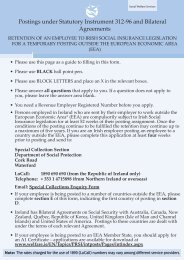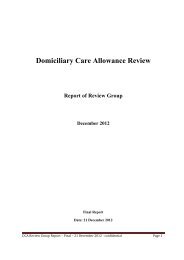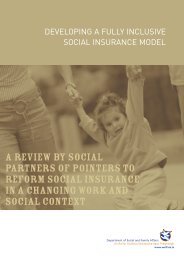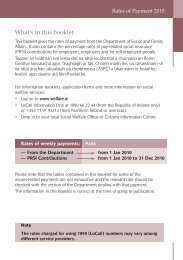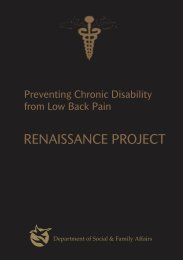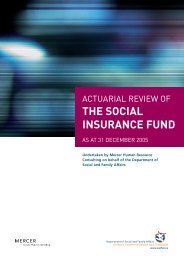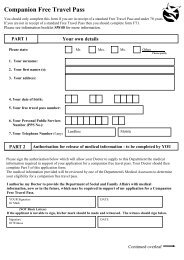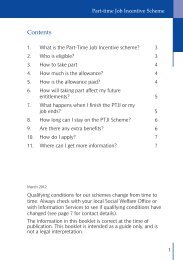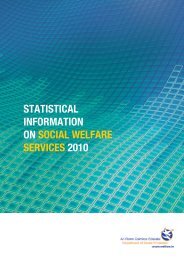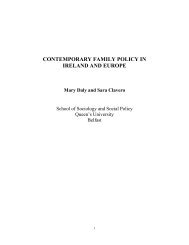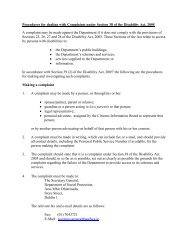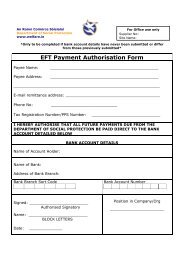PRSI contribution rates and user guide from 1 January ... - Welfare.ie
PRSI contribution rates and user guide from 1 January ... - Welfare.ie
PRSI contribution rates and user guide from 1 January ... - Welfare.ie
Create successful ePaper yourself
Turn your PDF publications into a flip-book with our unique Google optimized e-Paper software.
SW 14<br />
<strong>PRSI</strong> changes <strong>from</strong> 1 <strong>January</strong> 2014<br />
<br />
<br />
<br />
There are no changes to employee <strong>rates</strong> of <strong>PRSI</strong>.<br />
There are no changes to the rate of self-employed <strong>PRSI</strong> or in the minimum/flat rate<br />
self-employed <strong>PRSI</strong> payments.<br />
The Jobs Initiative announced in May 2011 included a time limited <strong>PRSI</strong> measure. This<br />
involved the halving of the lower rate of Class A Employer <strong>PRSI</strong> <strong>from</strong> 8.50% to 4.25%<br />
for the period 1 July 2011 to 31 December 2013. This lower rate appl<strong>ie</strong>s to<br />
employments where weekly earnings are €356 or less. The rate, as already provided<br />
for in legislation, reverts to 8.50% on 1 <strong>January</strong> 2014.<br />
<br />
In Budget 2013 it was announced that <strong>from</strong> 1 <strong>January</strong> 2014, the exemption <strong>from</strong> <strong>PRSI</strong><br />
applying to employed contributors <strong>and</strong> occupational pensioners (whether that pension<br />
arises <strong>from</strong> that person’s own employment or the employment of his or her spouse or<br />
civil partner) under 66 years, whose only additional income is unearned income, will<br />
be abolished. This means that unearned income such as rental income, investment<br />
income, dividends <strong>and</strong> interest on deposits <strong>and</strong> savings will be liable to <strong>PRSI</strong>.<br />
Full details of these <strong>and</strong> other changes are outlined inside <strong>and</strong> should be read carefully.<br />
<strong>PRSI</strong> <strong>contribution</strong><br />
<strong>rates</strong> <strong>and</strong> <strong>user</strong> <strong>guide</strong><br />
<strong>from</strong> 1 <strong>January</strong> 2014<br />
This booklet is intended as a <strong>guide</strong> only, <strong>and</strong> is not a legal<br />
interpretation.<br />
An Roinn Coimirce Sóisialaí<br />
Department of Social Protection<br />
www.welfare.<strong>ie</strong>
Class A<br />
Private <strong>and</strong> public sector employments<br />
Rates of <strong>contribution</strong> <strong>from</strong> 1 <strong>January</strong> 2014<br />
This covers employees under the age of 66 in industrial,<br />
commercial <strong>and</strong> service-type employment who have reckonable<br />
pay of €38 or more per week <strong>from</strong> all employments as well as<br />
Public Servants recruited <strong>from</strong> 6 April 1995.<br />
Weekly pay is the employee’s money pay plus notional pay (if applicable).<br />
Subclass<br />
Weekly pay<br />
b<strong>and</strong>*<br />
How much of<br />
weekly pay<br />
All income<br />
EE* ER<br />
AO<br />
AX<br />
AL<br />
A1<br />
€38 - €352 inclusive<br />
€352.01 - €356<br />
inclusive<br />
€356.01 - €500<br />
inclusive<br />
More than €500<br />
All Nil 8.50%<br />
All 4.00% 8.50%<br />
All 4.00% 10.75%<br />
All 4.00% 10.75%<br />
* Share-based remuneration may in certain circumstances be subject to employee<br />
<strong>PRSI</strong>. Employer’s <strong>PRSI</strong> is not chargeable on share-based remuneration.<br />
C o m m u n i t y E m p l o y m e n t p a r t i c i p a n t s o n l y<br />
Subclass<br />
Weekly pay<br />
b<strong>and</strong><br />
How much of<br />
weekly pay<br />
All income<br />
EE ER<br />
A8<br />
Up to €352<br />
inclusive<br />
All Nil 0.50%<br />
A9<br />
More than €352<br />
All 4.00% 0.50%<br />
Total <strong>PRSI</strong>: Calculate the employer <strong>and</strong> employee deductions separately <strong>and</strong> then add<br />
them together.<br />
2
Class B<br />
Public sector employments<br />
Rates of <strong>contribution</strong> <strong>from</strong> 1 <strong>January</strong> 2014<br />
This covers permanent <strong>and</strong> pensionable civil servants recruited<br />
before 6 April 1995, registered doctors <strong>and</strong> dentists employed in<br />
the civil service <strong>and</strong> Gardaí recruited prior to 6 April 1995.<br />
Subclass<br />
Weekly pay<br />
b<strong>and</strong>*<br />
How much of<br />
weekly pay<br />
All income<br />
EE ER<br />
BO<br />
BX<br />
B1<br />
Up to €352<br />
inclusive<br />
€352.01 - €500<br />
inclusive<br />
More than €500<br />
All Nil 2.01%<br />
All 0.90% 2.01%<br />
First €1,443 0.90% 2.01%<br />
Balance 4.00% 2.01%<br />
Class C<br />
This covers commissioned officers of the Defence Forces <strong>and</strong><br />
members of the Army Nursing Service recruited before 6 April<br />
1995.<br />
Subclass<br />
Weekly pay<br />
b<strong>and</strong>*<br />
How much of<br />
weekly pay<br />
All income<br />
EE ER<br />
CO<br />
CX<br />
C1<br />
Up to €352<br />
inclusive<br />
€352.01 - €500<br />
inclusive<br />
More than €500<br />
All Nil 1.85%<br />
All 0.90% 1.85%<br />
First €1,443 0.90% 1.85%<br />
Balance 4.00% 1.85%<br />
3
Class D<br />
Subclass<br />
Public sector employments<br />
Rates of <strong>contribution</strong> <strong>from</strong> 1 <strong>January</strong> 2014<br />
This covers permanent <strong>and</strong> pensionable employees in the public<br />
service, other than those mentioned in Classes B <strong>and</strong> C, recruited<br />
before 6 April 1995.<br />
Weekly pay<br />
b<strong>and</strong><br />
How much of<br />
weekly pay<br />
All income<br />
EE* ER<br />
DO<br />
DX<br />
D1<br />
Up to €352<br />
inclusive<br />
€352.01 - €500<br />
inclusive<br />
More than €500<br />
All Nil 2.35%<br />
All 0.90% 2.35%<br />
First €1,443 0.90% 2.35%<br />
Balance 4.00% 2.35%<br />
Class H<br />
This covers NCOs <strong>and</strong> enlisted personnel of the Defence Forces.<br />
Subclass<br />
Weekly pay<br />
b<strong>and</strong><br />
How much of<br />
weekly pay<br />
All income<br />
EE ER<br />
HO<br />
HX<br />
H1<br />
Up to €352<br />
inclusive<br />
€352.01 - €500<br />
inclusive<br />
More than €500<br />
All Nil 10.05%<br />
All 3.90% 10.05%<br />
All 3.90% 10.05%<br />
Class J<br />
Subclass<br />
JO<br />
J1<br />
P r i v a t e s e c t o r e m p l o y m e n t s<br />
This normally relates to people with reckonable pay of less than<br />
€38 per week (<strong>from</strong> all employments). However, a small number of<br />
employees are insurable at Class J, no matter how much they<br />
earn, such as employees aged 66 or over or people in subsidiary<br />
employment.<br />
Weekly pay<br />
b<strong>and</strong><br />
Up to €500<br />
inclusive<br />
How much of<br />
weekly pay<br />
All income<br />
EE* ER<br />
All Nil 0.50%<br />
More than €500 All Nil 0.50%<br />
* Share-based remuneration may in certain circumstances be subject to employee<br />
<strong>PRSI</strong>. Employer’s <strong>PRSI</strong> is not chargeable on share-based remuneration.<br />
4
Class K<br />
O f f i c e h o l d e r s<br />
Rates of <strong>contribution</strong> <strong>from</strong> 1 <strong>January</strong> 2014<br />
Since 2011, public office holders pay <strong>PRSI</strong> at a rate of 4% on all<br />
income, where their income is over €5,200 a year. They should be<br />
returned at Class K. Public office holders with weekly income of<br />
€100 or less should be returned at Class M. Class K may also apply<br />
in other circumstances, see Important Notice for details.<br />
Subclass<br />
Weekly pay<br />
b<strong>and</strong><br />
How much of<br />
weekly pay<br />
All income<br />
EE ER<br />
Record under<br />
Class M<br />
Up to €100<br />
inclusive<br />
All Nil Nil<br />
K1<br />
More than €100 All 4% Nil<br />
O c c u p a t i o n a l p e n s i o n s<br />
Class M<br />
Class M relates to people with a nil <strong>contribution</strong> liability (such as<br />
employees under age 16, people aged 66 or over (including those<br />
previously liable for Class S), persons in receipt of occupational<br />
pensions or lump-sum termination payments <strong>and</strong> public office<br />
holders with a weekly income of less than €100 a week).<br />
Subclass<br />
Weekly pay<br />
b<strong>and</strong><br />
How much of<br />
weekly pay<br />
All income<br />
EE ER<br />
M<br />
All income All Nil Nil<br />
S e l f - e m p l o y e d<br />
Class S<br />
Subclass<br />
SO<br />
S1<br />
This covers self-employed people, including certain company<br />
directors, <strong>and</strong> certain people with income <strong>from</strong> investments <strong>and</strong><br />
rent.<br />
Weekly pay<br />
b<strong>and</strong><br />
Up to €500<br />
inclusive<br />
How much of<br />
weekly pay<br />
All income <strong>from</strong><br />
Self-Employment<br />
All 4%<br />
More than €500 All 4%<br />
5
Important Notice<br />
Changes to Employee <strong>PRSI</strong><br />
<strong>PRSI</strong> changes <strong>from</strong> 1 <strong>January</strong> 2014.<br />
There are no changes to employee <strong>rates</strong> of <strong>PRSI</strong>.<br />
Broadening of the income base on which <strong>PRSI</strong> is charged<br />
In Budget 2013 it was announced that <strong>from</strong> 1 <strong>January</strong> 2014, the exemption <strong>from</strong> <strong>PRSI</strong><br />
applying to employed contributors <strong>and</strong> occupational pensioners (whether that pension<br />
arises <strong>from</strong> that person’s own employment or the employment of his or her spouse or<br />
civil partner) under 66 years, whose only additional income is unearned income, will be<br />
abolished. This means that unearned income such as rental income, investment<br />
income, dividends <strong>and</strong> interest on deposits <strong>and</strong> savings will be liable to <strong>PRSI</strong>. This<br />
income will be chargeable to <strong>PRSI</strong> at Class K.<br />
Minimum/Flat rate Self-employed Payments<br />
There are no changes to the rate of self-employed <strong>PRSI</strong> or in the minimum/flat rate<br />
self-employed <strong>PRSI</strong> payments.<br />
Taxation of Maternity Benefit<br />
Since 1st July 2013, Maternity Benefit is taxed in full. No tax is deducted at source by<br />
the Department of Social Protection.<br />
If you have any enquir<strong>ie</strong>s about taxation of social welfare benefits, contact your local tax<br />
office or log on to www.revenue.<strong>ie</strong>.<br />
An Roinn Coimirce Sóisialaí<br />
Department of Social Protection<br />
www.welfare.<strong>ie</strong><br />
6
S u m m a r y o f P R S I c l a s s e s<br />
<strong>PRSI</strong> USER GUIDE<br />
Class A employment<br />
■ The pay/income threshold to determine whether employees pay <strong>PRSI</strong> at Class A or J<br />
remains at €38.<br />
■ Employees paid €38 to €352 inclusive in any week should be recorded under subclass<br />
AO.<br />
■ Employees paid €352.01 to €356 inclusive in any week should be recorded under<br />
subclass AX.<br />
■ Employees paid €356.01 to €500 inclusive in any week should be recorded under<br />
subclass AL.<br />
■ In any week that an employee is paid more than €500, it should be recorded under<br />
subclass A1 or A4.<br />
■ Participants in Community Employment who are paid €352, or less in any week should be<br />
recorded under Subclass A8. In any week that the pay is more than €352 record under<br />
subclass A9.<br />
■ Community Employment supervisors <strong>and</strong> employees on apprenticeship schemes are<br />
insurable at Class A in the normal way.<br />
Class J employment<br />
■ The Class J <strong>contribution</strong> normally relates to people paid less than €38 per week (<strong>from</strong><br />
all employments). However, a small number of employees are insurable at Class J no<br />
matter how much they are paid, such as employees aged 66 or over <strong>and</strong> people in<br />
subsidiary employment (defined on Page 13).<br />
Other classes<br />
■ In any week that an employee is paid more than €500, it should be recorded under<br />
subclass B1, C1, H1, J1 or S1, where appropriate.<br />
■ Class B, C, D or H employees paid up to €352 inclusive in any week should be recorded<br />
under subclass BO, CO, DO or HO.<br />
■ Class B, C, D or H employees paid between €352.01 <strong>and</strong> €500 inclusive should be recorded<br />
under subclass BX, CX, DX or HX.<br />
■ For people covered under Class J or S <strong>and</strong> paid up to €500 inclusive in any week, record<br />
under subclass O, that is, JO or SO as appropriate.<br />
■ <strong>PRSI</strong> classes B, C <strong>and</strong> D will pay <strong>PRSI</strong> at 0.9% up to €1,443 a week <strong>and</strong> 4% above €1,443 a<br />
week.<br />
■ Modif<strong>ie</strong>d rate contributors with self-employed earned income <strong>and</strong> any other unearned<br />
income are liable to <strong>PRSI</strong> at Class K. Employed contributors <strong>and</strong> occupational<br />
pensioners, aged under 66 years, whose only additional income is unearned income are<br />
liable to <strong>PRSI</strong> on such income at Class K. This means that unearned income such as<br />
rental income, investment income, dividends <strong>and</strong> interest on deposits <strong>and</strong> savings will<br />
be liable to <strong>PRSI</strong>.<br />
■ Civil <strong>and</strong> public servants will pay <strong>PRSI</strong> on the ‘Pension Levy’ portion of their salar<strong>ie</strong>s.<br />
Civil <strong>and</strong> public service employers do not have to pay any employer <strong>PRSI</strong> on the<br />
‘Pension levy’.<br />
7
<strong>PRSI</strong> for the self-employed<br />
Self-employed people, other than self-employed company directors, must register with the Revenue<br />
Commissioners for <strong>PRSI</strong> purposes. Under the self assessment system, <strong>PRSI</strong> is paid to the local tax<br />
office together with any other payment due. Self-employed company directors pay their <strong>PRSI</strong> under<br />
the PAYE system.<br />
Minimum/Flat rate Self-employed Payments<br />
■ Self-employed contributors with annual self-employed income over €5,000 pay Class S <strong>PRSI</strong> at<br />
the rate of 4%, subject to a minimum payment of €500.<br />
■ For those with an annual self-employed income in excess of €5,000 but who have no net liability<br />
to tax, the Class S flat rate of payment is €310.<br />
■ The flat rate of payment of Voluntary Contributions made by former self-employed contributors<br />
is €500.<br />
For further information, contact Cl<strong>ie</strong>nt Eligibility Services, LoCall: 1890 690 690 (<strong>from</strong> the Republic<br />
of Irel<strong>and</strong> only) or +353 1 471 5898 (<strong>from</strong> Northern Irel<strong>and</strong> or overseas).<br />
If a person is no longer liable to pay <strong>PRSI</strong>, they may apply to become a voluntary contributor.<br />
For more information, log on to www.welfare.<strong>ie</strong>.<br />
Components of the <strong>PRSI</strong> <strong>contribution</strong><br />
The Pay Related Social Insurance (<strong>PRSI</strong>) <strong>contribution</strong> is made up of a number of different<br />
components including:<br />
■ social insurance at the appropriate percentage rate for employees <strong>and</strong> employers, which var<strong>ie</strong>s<br />
according to the pay <strong>and</strong> <strong>PRSI</strong> Class of the employee <strong>and</strong> benefits for which he or she is<br />
insured.<br />
■ the 0.70% National Training Fund Levy, included in the employer’s <strong>contribution</strong> in Classes A <strong>and</strong> H.<br />
Levels of payment<br />
<strong>PRSI</strong> <strong>contribution</strong>s will be payable as follows:<br />
■ at the appropriate percentage <strong>rates</strong> for employees on all reckonable earnings.<br />
■ on all reckonable pay, the employer’s share (social insurance <strong>and</strong> the 0.70% National Training<br />
Fund Levy in classes A <strong>and</strong> H) is due.<br />
■ Class S, social insurance at 4.00% on all reckonable income.<br />
The National Training Fund Levy is included in the <strong>contribution</strong> <strong>rates</strong> outlined on pages 2 to 5<br />
where applicable.<br />
8
Reckonable pay<br />
<strong>PRSI</strong> is calculated on the employee’s reckonable pay. Reckonable pay is the gross money pay plus<br />
notional pay (or benefit in kind) if applicable.<br />
The net value of share-based remuneration is to be treated as notional pay.<br />
■ The net value of share-based remuneration is to be treated as notional pay for the purposes of<br />
calculating employee <strong>PRSI</strong> only.<br />
■ Employee <strong>PRSI</strong> only is payable on share-based remuneration. There is no employer <strong>PRSI</strong><br />
chargeable on share-based remuneration.<br />
■ The obligation to deduct <strong>and</strong> remit <strong>PRSI</strong> in respect of share-based remuneration generally rests<br />
with the employer. Accordingly the <strong>PRSI</strong> payable should be deducted by the employer through<br />
payroll along with other <strong>PRSI</strong> liabilit<strong>ie</strong>s <strong>and</strong> remitted to the Collector-General with the monthly<br />
P30 return.<br />
■ Different arrangements may apply in the case of <strong>PRSI</strong> on gains <strong>from</strong> the exercise of certain<br />
share options.<br />
More detailed information on the treatment of share-based remuneration for <strong>PRSI</strong> purposes is<br />
contained at:<br />
http://www.welfare.<strong>ie</strong>/en/Pages/<strong>PRSI</strong>-on-Share-Based-Remuneration.aspx <strong>and</strong><br />
www.revenue.<strong>ie</strong> (Revenue - Irish Tax & Customs).<br />
<strong>PRSI</strong> is fully chargeable on payments by private sector employees in respect of:<br />
Superannuation <strong>contribution</strong>s<br />
Permanent health benefit schemes (including income continuance schemes)<br />
Revenue approved schemes established under irrevocable trusts, overseas pension schemes<br />
<strong>and</strong> other Revenue exempt approved schemes<br />
Personal Retirement Savings Accounts<br />
Deductions in respect of Revenue approved retirement funds.<br />
Civil <strong>and</strong> Public Service employers do not pay employer <strong>PRSI</strong> on the pension levy paid by their<br />
employees. Employee <strong>PRSI</strong> is chargeable.<br />
9
<strong>PRSI</strong> <strong>contribution</strong> weeks<br />
A <strong>contribution</strong> week is each successive period of seven days starting on 1 <strong>January</strong> each year. Week 1<br />
is the period <strong>from</strong> 1 to 7 <strong>January</strong> inclusive, week 2 <strong>from</strong> 8 to 14 <strong>January</strong> <strong>and</strong> so on. For 2014, the<br />
<strong>contribution</strong> week starts on a Wednesday <strong>and</strong> ends on a Tuesday.<br />
A <strong>contribution</strong> at the appropriate class should be awarded to an employee for each <strong>contribution</strong><br />
week or part of one, for which he or she is in insurable employment.<br />
Voluntary <strong>contribution</strong>s<br />
People who were insured at Classes A, B, C, D, H or S <strong>and</strong> who are no longer insurably employed<br />
may opt to pay Voluntary Contributions to provide cover for pensions.<br />
Applications must be made within 12 months <strong>from</strong> the end of the <strong>PRSI</strong> <strong>contribution</strong> year in which a<br />
<strong>PRSI</strong> <strong>contribution</strong> was last paid or credited. For more information, log on to www.welfare.<strong>ie</strong> or<br />
contact:<br />
Cl<strong>ie</strong>nt Eligibility Services<br />
Cork Road<br />
Waterford<br />
Telephone: (01) 471 5898<br />
LoCall: 1890 690 690 (<strong>from</strong> the Republic of Irel<strong>and</strong> only)<br />
If calling <strong>from</strong> outside the Republic of Irel<strong>and</strong> please call +353 1 471 58978.<br />
10
Earnings b<strong>and</strong>s <strong>and</strong> subclasses<br />
Rates of <strong>contribution</strong> for 2014<br />
Subclass<br />
AO<br />
AX<br />
AL<br />
A1<br />
A8<br />
A9<br />
BO<br />
BX<br />
B1<br />
CO<br />
CX<br />
C1<br />
DO<br />
DX<br />
D1<br />
HO<br />
HX<br />
JO<br />
J1<br />
M<br />
K1<br />
SO<br />
S1<br />
Weekly pay b<strong>and</strong><br />
€38 to €352<br />
€352.01 to €356<br />
Up to €352<br />
Up to €352<br />
Up to €352<br />
Up to €352<br />
Up to €352<br />
Fortnightly pay b<strong>and</strong><br />
€76* to €704<br />
Up to €704<br />
Up to €704<br />
Up to €704<br />
Up to €704<br />
Up to €704<br />
Monthly pay b<strong>and</strong><br />
€165* to €1,525<br />
€704.01 to €712 €1,525.01 to €1,543<br />
€356.01 to €500 €712.01 to €1,000 €1,543.01 to €2,167<br />
More than €500 More than €1,000 More than €2,167<br />
Up to €1,525<br />
More than €352 More than €704 More than €1,525<br />
€352.01 to €500<br />
€352.01 to €500<br />
€352.01 to €500<br />
€352.01 to €500<br />
€704.01 to €1,000<br />
€704.01 to €1,000<br />
€704.01 to €1,000<br />
€704.01 to €1,000<br />
Up to €1,525<br />
€1,525.01 to €2,167<br />
More than €500 More than €1,000 More than €2,167<br />
Up to €1,525<br />
€1,525.01 to €2,167<br />
More than €500 More than €1,000 More than €2,167<br />
Up to €1,525<br />
€1,525.01 to €2,167<br />
More than €500 More than €1,000 More than €2,167<br />
Up to €1,525<br />
€1,525.01 to €2,167<br />
H1 More than €500 More than €1,000 More than €2,167<br />
Up to €500 Up to €1,000 Up to €2,167<br />
More than €500 More than €1,000 More than €2,167<br />
All income All income All income<br />
More than €100 More than €200 More than €433<br />
Up to €500 Up to €1,000 Up to €2,167<br />
More than €500 More than €1,000 More than €2,167<br />
*This threshold only appl<strong>ie</strong>s to Class A employees, whose total earnings in<br />
each week of the fortnight or month are at least €38.<br />
Subclasses A8 <strong>and</strong> A9 are only used for CE participants. Subclasses A4, A6 <strong>and</strong><br />
A7 are only used for existing approved employees under the Employer’s <strong>PRSI</strong><br />
Exemption Scheme. For further information contact Employment Support<br />
Services, telephone: 071 96 72698.<br />
11
Impor tant information<br />
Possible refund of Health Contribution paid in 2010<br />
Where employees earned more than €26,000 in 2010 they were liable to pay the Health<br />
Contribution <strong>and</strong> are not due a refund. If they earned less than €26,000 <strong>and</strong> never earned more<br />
than €500 in any one week they would not have been charged the Health Contribution <strong>and</strong> are not<br />
eligible for a refund. Employees may be entitled to a refund of the Health Contribution if they have<br />
earned less than €26,000 in 2010 <strong>and</strong> earned more than €500 in any particular week in that year.<br />
The employee may claim a refund of the Health Contribution after year end <strong>from</strong>:<br />
Department of Social Protection,<br />
<strong>PRSI</strong> Refunds,<br />
Oisín House,<br />
Pearse St.,<br />
Dublin 2.<br />
Telephone: (01) 673 2586.<br />
Application for refunds must be made within 4 years of the end of the relevant tax year. The<br />
Health Contribution has been included in the Universal Social Charge (USC) since 1st <strong>January</strong> 2011<br />
<strong>and</strong> no Health Contribution refunds arise after that date.<br />
Holiday pay<br />
If you pay an employee for a period of more than a week, it is important to determine the subclass<br />
correctly for each week.<br />
Example: An employee receives two weeks holiday pay with a current week’s wages. To determine<br />
the correct <strong>PRSI</strong> subclass, calculate the pay for each week <strong>and</strong> record the <strong>contribution</strong>s accordingly.<br />
This arrangement also appl<strong>ie</strong>s when an employer pays holiday pay when an employee leaves the<br />
employment.<br />
Sick pay<br />
Payment of Illness Benefit <strong>and</strong> Injury Benefit can be made directly to your company where sick pay<br />
arrangements require the employee(s) to h<strong>and</strong> over Illness Benefit or Injury Benefit payments to their<br />
employers. The Illness Benefit Claim Form/First Medical Certificate (MC 1) has a section where the<br />
employee can indicate that any payment(s) due can issue directly to the employer.<br />
Taxation of Jobseekers <strong>and</strong> Illness Benefit<br />
Both Illness Benefit <strong>and</strong> Jobseeker’s Benefit are considered as income for tax purposes <strong>and</strong> are taxed<br />
<strong>from</strong> the first day of payment, with the exception of payments for qualif<strong>ie</strong>d child(ren) which are not<br />
taxable. This Department will notify you of the amount of Illness Benefit to be taken into account for<br />
tax purposes, where appropriate. Taxation of Jobseeker’s Benefit will still be mainly appl<strong>ie</strong>d through<br />
the tax office.<br />
Maternity Benefit, Adoptive Benefit <strong>and</strong> Health <strong>and</strong> Safety Benefit<br />
Since 1 July 2013 Maternity Benefit, Adoptive Benefit <strong>and</strong> Health & Safety Benefit payments are<br />
taxable in full. These benefits are exempt <strong>from</strong> USC <strong>and</strong> <strong>PRSI</strong>. Individuals who pay their tax through<br />
the PAYE system will, where possible, automatically have their annual tax credits <strong>and</strong> rate b<strong>and</strong>s<br />
reduced by the amount of these payments. Revenue will receive details of the benefit <strong>from</strong> the<br />
Department of Social Protection. Employers will be advised by the Revenue Commissioners of the<br />
adjusted tax credits <strong>and</strong> rate b<strong>and</strong>s on employer tax credit certificates.<br />
If you have any enquir<strong>ie</strong>s about taxation of social welfare benefits, contact your local tax office or<br />
log on to www.revenue.<strong>ie</strong>.<br />
Completion of P45<br />
Where an employee leaves his or her employment, a form P45 should be completed <strong>and</strong> given to the<br />
employee immediately. The P45 is very important <strong>and</strong> may be required as evidence of entitlement<br />
to social welfare payments.<br />
12
Lump sum payments<br />
Lump sum payments made to employees when they leave employment are not regarded as<br />
reckonable pay for <strong>PRSI</strong> purposes <strong>and</strong> should be recorded under Class M. These include redundancy,<br />
gratuit<strong>ie</strong>s <strong>and</strong> ex-gratia payments.<br />
National Training Fund Levy<br />
The National Training Fund Levy of 0.70% is included in the employer’s share of <strong>PRSI</strong> under Class A<br />
<strong>and</strong> H, with no change in the overall rate payable by the employers.<br />
Maintenance payments<br />
A separated person may claim a refund of <strong>PRSI</strong> on enforceable maintenance payments made to his or<br />
her spouse. The <strong>PRSI</strong> due will be re-calculated on the reckonable pay/income reduced by the<br />
amount of maintenance payment. Any excess <strong>PRSI</strong> paid will be returned by claiming a refund after<br />
year end, <strong>from</strong> the <strong>PRSI</strong> Refunds Section, Oisín House, Pearse St., Dublin 2, telephone: (01) 673 2586.<br />
Subsidiary employments<br />
Subsidiary employment, which is insurable at Class J regardless of earnings, is defined in legislation. It<br />
includes, for example, employment of people who are also insurable at Class B, C, D or H in their<br />
main employment.<br />
Personal Public Service Number (PPS No.)<br />
It is vital that the correct PPS No. is shown on your P35 end of year return for each employee. If you<br />
need assistance in tracing the PPS No.(s) for your employee(s), please have them contact<br />
Cl<strong>ie</strong>nt Identity Services, telephone: (01) 704 3281.<br />
Recording of <strong>contribution</strong>s<br />
For the year 2013 <strong>and</strong> subsequent years, the gross pay on the form P35 (end of year return) for<br />
each employee should include any taxable benefit (notional pay) received by that employee during<br />
the year. In addition, the total amount of taxable benefits in the year for all employees should be<br />
included in the appropriate section of the summary page of the P35.<br />
The P35 should not include any class or subclass of <strong>PRSI</strong> that did not apply during the tax<br />
year.<br />
If the employee changes class (for example Class AO <strong>and</strong> JO) an aggregate total of weeks for all<br />
classes should be included on the P35.<br />
If more than two classes or subclasses are involved during the year, you should provide full details on<br />
a separate sheet or computer printout showing the classes <strong>and</strong> number of weeks of insurable<br />
employment in each class or subclass.<br />
You must use Form P35 LT when the PPS No. is unknown, but you still record the employee’s name,<br />
address, date of birth <strong>and</strong> mother’s birth surname.<br />
If you need help<br />
Further information on <strong>PRSI</strong> Rates is available including a range of information for employers on our<br />
website at www.welfare.<strong>ie</strong>.<br />
13
PENSIONS REMINDER<br />
If you have employees approaching retirement age, it is important that<br />
they apply on time for a pension.<br />
State Pension (Transition) at age 65<br />
State Pension (Transition) is being abolished <strong>from</strong> the 1st of <strong>January</strong><br />
2014.<br />
This means State Pension (Transition) will no longer be payable for<br />
claimants whose date of birth is on or after the 1st of <strong>January</strong> 1949.<br />
State Pension (Contributory) at age 66<br />
A person may continue working after age 66 <strong>and</strong> also get this<br />
pension <strong>from</strong> the Department of Social Protection. On reaching age<br />
66 an employee is liable for <strong>PRSI</strong> at Class J only.<br />
Self-employed people who pay Class S <strong>PRSI</strong> <strong>contribution</strong>s can also<br />
continue to work <strong>and</strong> qualify for this payment provided that their<br />
social insurance liabilit<strong>ie</strong>s are in order. People who are liable for<br />
Class S <strong>PRSI</strong> <strong>contribution</strong>s <strong>and</strong> who are approaching age 66 should<br />
check with their local Revenue Office to ensure their tax affairs are<br />
in order to avoid delays.<br />
They should apply 3 months before they reach age 66.<br />
How to apply<br />
Application forms are available <strong>from</strong> your local Social <strong>Welfare</strong> Office,<br />
post office, Citizens Information Centre or may also be downloaded<br />
<strong>from</strong> our website at www.welfare.<strong>ie</strong>.<br />
Taxation<br />
State Pensions are liable to tax <strong>and</strong> any quer<strong>ie</strong>s in relation to the<br />
taxation of these payments should be made to your local Revenue<br />
Office.<br />
14



